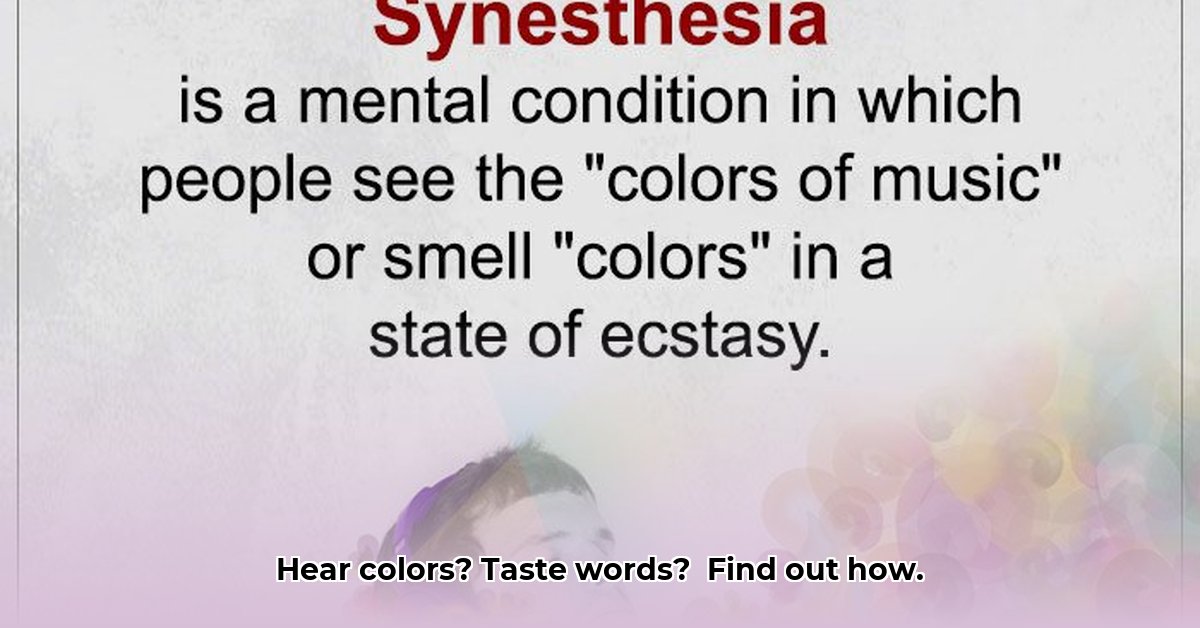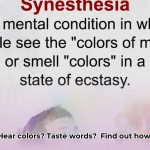Imagine tasting words, hearing colors, or associating numbers with distinct personalities. This isn’t science fiction; it’s the daily reality for individuals with synesthesia. This neurological phenomenon, where senses intertwine, affects an estimated 2-4% of the population, offering a fascinating glimpse into the brain’s complex workings. For more on exceptional memory, see this article. This article delves into the science of synesthesia, exploring its various forms, potential causes, and the unique insights it provides into perception, creativity, and learning.
The Sensory Symphony: Defining Synesthesia
Synesthesia, derived from the Greek words “syn” (together) and “aesthesis” (sensation), is a neurological condition characterized by the blending of senses. It occurs when stimulation of one sensory pathway involuntarily triggers an experience in another. This cross-modal perception is consistent and unique for each individual, making the world a richer, more vibrant place for synesthetes. Synesthesia is not a disease or disorder, but rather a variation in how the brain processes sensory information.
Common Characteristics of Synesthesia:
- Involuntariness: Synesthetic experiences are automatic and not consciously controlled.
- Consistency: The associations between senses remain stable over time for each synesthete.
- Specificity: Each synesthete has unique and distinct sensory pairings.
- Projected or Associated: Some synesthetes “see” the secondary sensation externally, while others experience it internally as a mental association.
Unveiling the Varieties: Types of Synesthesia
Synesthesia manifests in a multitude of forms, reflecting the diverse ways in which our senses can intertwine. While any combination of senses is theoretically possible, some types are more commonly reported than others.
Common Types of Synesthesia:
- Grapheme-Color Synesthesia: Letters, numbers, or characters evoke specific colors. For example, the letter “A” might always appear red, or the number “5” might be blue.
- Chromesthesia: Sounds, music, or voices trigger color sensations. Different musical notes or timbres might evoke specific hues or patterns.
- Lexical-Gustatory Synesthesia: Words or phonemes evoke taste sensations. Hearing the word “table” might trigger the taste of chocolate, or the name “John” might taste like coffee.
- Number-Form Synesthesia: Numbers are mentally arranged in a specific spatial map. Synesthetes might “see” a number line extending into the distance or a calendar year arranged in a particular shape.
- Spatial-Sequence Synesthesia: Sequences, such as months or days of the week, are associated with specific locations in space. The month of January might always be perceived as being to the left of February.
- Mirror-Touch Synesthesia: Individuals experience tactile sensations when observing someone else being touched. Watching someone’s cheek being stroked might evoke a similar sensation on their own face.
This is not an exhaustive list, and researchers continue to identify new and unusual forms of synesthesia. The diversity of synesthetic experiences underscores the complexity and plasticity of the human brain.
Decoding the Mechanisms: What Causes Synesthesia?
While the exact causes of synesthesia remain a subject of ongoing research, scientists have identified several key factors that likely contribute to its development.
Genetic Predisposition:
Synesthesia tends to run in families, suggesting a strong genetic component. Studies have shown that individuals with a first-degree relative who has synesthesia are more likely to experience it themselves. While no single “synesthesia gene” has been identified, researchers believe that multiple genes may be involved, each contributing to the likelihood of developing the condition.
Brain Connectivity:
Neuroimaging studies, such as fMRI and diffusion tensor imaging (DTI), have revealed differences in brain structure and function in synesthetes compared to non-synesthetes. These studies often show increased connectivity between brain regions associated with different senses. For example, individuals with grapheme-color synesthesia may have stronger connections between the visual cortex (responsible for processing visual information) and the color processing areas of the brain.
Neural Pruning:
One theory suggests that synesthesia may result from a failure of normal neural pruning during development. During early childhood, the brain undergoes a process of synaptic pruning, where unnecessary connections between neurons are eliminated. It’s hypothesized that in synesthetes, this pruning process may be less extensive, resulting in the retention of connections between sensory areas that are typically segregated.
Neurotransmitters:
Research suggests that certain neurotransmitters, such as serotonin and dopamine, may play a role in synesthesia. Studies have found associations between synesthesia and variations in genes related to the serotonin system. However, further research is needed to fully understand the role of neurotransmitters in the development and expression of synesthesia.
The Synesthetic Advantage: Creativity, Memory, and Beyond
While synesthesia was once considered a rare and unusual phenomenon, researchers are increasingly recognizing its potential benefits. Synesthetes often report enhanced creativity, memory, and cognitive abilities.
Creativity:
Synesthesia has long been associated with creativity and artistic expression. Many famous artists, musicians, and writers throughout history are believed to have had synesthesia, including Wassily Kandinsky, David Hockney, and Vladimir Nabokov. The blending of senses can provide a unique perspective and inspire novel ideas and creations.
Memory:
Synesthetes often have exceptional memory abilities, particularly for information related to their synesthetic associations. For example, individuals with grapheme-color synesthesia may find it easier to remember phone numbers or dates by associating them with specific colors. The additional sensory information provided by synesthesia can serve as a mnemonic device, enhancing encoding and retrieval processes.
Cognitive Abilities:
Some studies have suggested that synesthetes may have advantages in certain cognitive tasks, such as visual search and pattern recognition. The increased connectivity between brain regions may allow synesthetes to process information more efficiently and make connections that others might miss.
Navigating Synesthesia: Challenges and Considerations
While synesthesia is often associated with positive attributes, it’s important to acknowledge that some individuals may experience challenges related to their condition.
Sensory Overload:
In some cases, the constant influx of sensory information can be overwhelming, leading to sensory overload and difficulty focusing. This is particularly true in environments with high levels of stimulation, such as crowded cities or loud concerts.
Social Challenges:
Synesthetes may sometimes feel isolated or misunderstood, particularly if they are not aware that their sensory experiences are different from those of others. Sharing their experiences with others can be difficult, as non-synesthetes may struggle to comprehend the blending of senses.
Learning Difficulties:
In rare cases, synesthesia may interfere with learning, particularly if the synesthetic associations conflict with conventional learning materials. For example, a child with grapheme-color synesthesia may struggle to learn to read if the colors associated with letters in a textbook are different from their own internal associations.
It’s important to note that these challenges are not universal and that many synesthetes lead fulfilling and successful lives. Understanding the potential challenges associated with synesthesia can help individuals and educators develop strategies to mitigate any negative impacts.
The Future of Synesthesia Research: Unlocking the Brain’s Secrets
Research on synesthesia is rapidly advancing, thanks to advances in neuroimaging techniques and genetics. Scientists are continuing to explore the underlying mechanisms of synesthesia, its relationship to creativity and cognition, and its potential applications in education and therapy.
Genetic Studies:
Large-scale genetic studies are underway to identify the specific genes associated with synesthesia. These studies involve analyzing the genomes of thousands of synesthetes and comparing them to those of non-synesthetes. Identifying these genes could provide valuable insights into the biological basis of synesthesia and potentially lead to new diagnostic and therapeutic strategies.
Neuroimaging Studies:
Researchers are using advanced neuroimaging techniques to study the brain activity of synesthetes in real-time. These studies are helping to identify the specific brain regions and neural pathways involved in synesthetic experiences. By understanding how the brain processes sensory information differently in synesthetes, scientists can gain a deeper understanding of the neural basis of consciousness and perception.
Educational Applications:
Educators are exploring ways to harness the potential benefits of synesthesia to enhance learning. For example, incorporating color-coding techniques or multisensory activities into the classroom can help students with and without synesthesia to improve memory, creativity, and engagement.
Therapeutic Applications:
Researchers are investigating the potential of synesthesia-based therapies for a variety of conditions, including anxiety, depression, and chronic pain. By understanding how sensory experiences can influence emotions and behavior, therapists can develop targeted interventions to improve mental and physical well-being.
Synesthesia is a captivating phenomenon that offers a unique window into the workings of the human brain. By continuing to explore its mysteries, scientists can unlock new insights into perception, creativity, and consciousness, paving the way for innovative approaches to education, therapy, and artistic expression.
Synesthesia in the Classroom: Enhancing Learning Through Sensory Integration
Synesthesia, the blending of senses, isn’t just a curious neurological phenomenon – it’s a potential catalyst for revolutionizing education. By understanding and harnessing the unique sensory experiences of synesthetes, educators can create more engaging, effective, and inclusive learning environments for all students.
Understanding Synesthesia in the Educational Context:
Synesthesia can manifest in various ways that impact learning:
- Grapheme-color synesthesia: Students may associate specific colors with letters or numbers, influencing their reading comprehension and mathematical abilities.
- Chromesthesia: Music or sounds may evoke color sensations, impacting their appreciation and understanding of auditory arts.
- Lexical-gustatory synesthesia: Words may trigger taste sensations, creating unique and memorable associations with vocabulary and language learning.
Strategies for Integrating Synesthesia-Based Learning:
- Multisensory Activities: Incorporate activities that engage multiple senses simultaneously, such as using colored blocks to teach math concepts or playing music to inspire creative writing.
- Color-Coding Techniques: Use color-coding to highlight key information, organize notes, and improve memory recall. For example, assigning different colors to different historical periods or scientific concepts.
- Personalized Learning: Recognize that each student’s synesthetic experiences are unique and tailor learning strategies to their individual needs and preferences.
- Creative Expression: Encourage students to express their synesthetic experiences through art, music, writing, or other creative mediums.
Benefits of Synesthesia-Based Learning:
- Enhanced Memory: Synesthetic associations can create stronger and more memorable connections between concepts and information, improving memory recall.
- Increased Engagement: Multisensory activities can make learning more engaging and stimulating, capturing students’ attention and fostering a love of learning.
- Improved Understanding: By connecting concepts to sensory experiences, students can gain a deeper and more intuitive understanding of the material.
- Inclusivity: Recognizing and valuing synesthetic experiences can create a more inclusive learning environment for all students, celebrating sensory diversity.
Addressing Potential Challenges:
- Sensory Overload: Be mindful of students who may be sensitive to sensory overload and provide quiet spaces or alternative activities as needed.
- Conflicting Associations: Recognize that some students’ synesthetic associations may conflict with conventional learning materials and provide alternative resources or strategies.
- Misunderstanding: Educate students and teachers about synesthesia to promote understanding and acceptance.
The Future of Synesthesia in Education:
As research on synesthesia continues to advance, educators will have access to new insights and tools for harnessing its potential in the classroom. By embracing sensory integration and personalized learning, we can create educational environments that empower all students to thrive.
- Robot Reporters: Ethics of AI in Journalism; A Guide to Trust - August 3, 2025
- Astonishing Savant Memories: Unlocking Brain Secrets Now - August 3, 2025
- Quantum Entanglement Explained: Einstein’s Spooky Action & Tech Revolution - August 3, 2025















